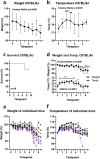Surface temperature changes indicate disease onset after pulmonary murine corona virus infection, but do not constitute a humane endpoint
- PMID: 40580228
- PMCID: PMC12206167
- DOI: 10.1007/s11259-025-10806-9
Surface temperature changes indicate disease onset after pulmonary murine corona virus infection, but do not constitute a humane endpoint
Abstract
Mouse models are important contributors for understanding the immune system during infections. Objective parameters help to assess the course of infection and guarantee animal welfare. In this study we analyzed if surface temperature measured via thermal imaging of the dorsal area is a suitable marker to evaluate animal wellbeing during murine coronavirus (MCoV) infection. Infected BALB/c mice displayed severe symptoms whereas C57BL/6 mice were less affected. In BALB/c animals, temperature increased from 27.1 °C to 28.4 °C within 24 h with levels remaining slightly elevated over the observation period. In contrast, a decrease in body weight was consistent through the period with 60% of the animals reaching the previously set termination point of 20% weight loss (n = 6). Also, C57BL/6J animals showed a significant temperature increase from 27.1 °C to 28.4 °C within 24 h and a significant weight loss over time with two out of ten reached weight loss end point. However, temperature and weight changes were not related in individual animals. In contrast to temperature values, body weight clearly set a trajectory towards early termination. Taken together, our data indicate that superficial temperature did not serve as a predictive parameter for defining humane end points, but indicate disease onset after pulmonary virus infection.
Keywords: Humane endpoint; Murine coronavirus; Surface temperature; Viral infections.
© 2025. The Author(s).
Conflict of interest statement
Declarations. Ethical approval: All mouse experiments were approved by the Animal Care and Use Committee of the Medical University of Vienna and the Austrian Federal Ministry of Education, Science and Research (2022 − 0.351.574 and 2022 − 0.386.446). Competing interests: The authors declare no competing interests.
Figures



References
-
- Ashall V, Millar K (2014) Endpoint matrix: a conceptual tool to promote consideration of the multiple dimensions of humane endpoints. ALTEX 31:209–213. 10.14573/altex.1307261 - PubMed
-
- Ellis T, Katsiadaki I (2021) Clarification of early end-points for refinement of animal experiments, with specific reference to fish. Lab Anim 55:244–253. 10.1177/0023677220971002 - PubMed
-
- Kort WJ, Hekking-Weijma JM, TenKate MT, Sorm V, VanStrik R (1998) A microchip implant system as a method to determine body temperature of terminally ill rats and mice. Lab Anim 32:260–269. 10.1258/002367798780559329 - PubMed
MeSH terms
LinkOut - more resources
Full Text Sources

